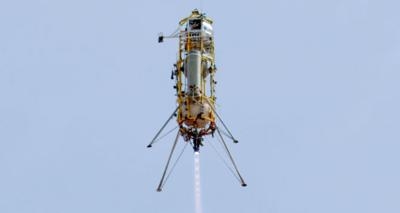System Designed By Draper And Masten Space Systems
A rocket-powered, vertical-landing space-access technology demonstrator reached its highest altitude and furthest distance to date March 25 at the Mojave Air and Space Port in Mojave, CA, using a developmental navigation system designed to land a space vehicle on other celestial bodies. Masten Space Systems’ XA-0.1B “Xombie” suborbital rocket lifted off the launch pad for an 80-second flight while being controlled by Charles Stark Draper Laboratory’s Guidance Embedded Navigator Integration Environment (GENIE) system developed under NASA's Flight Opportunities Program.

This combined capability of a rocket-powered demonstrator and a closed-loop planetary Guidance, Navigation and Control system allows NASA to begin testing prototype landing instruments for future missions to the Moon or Mars under realistic conditions without leaving Earth. "Two hundred meters above the Martian or lunar surface is not the place you want to be using an innovative new sensor or landing algorithm for the first time," explained Christopher Baker of the Flight Opportunities Program at NASA's Dryden Flight Research Center at Edwards Air Force Base. "We are working to create an environment that provides opportunities to test these systems a little closer to home."
Xombie rose 1,626 feet – higher than New York's Empire State Building – moving in a trajectory that replicated the speed and angle of a planetary approach. It landed 984 feet, nearly 300 meters, away from the take off site. The flight established a test-bed capability that will allow for landing demonstrations that start at much higher altitudes—several miles above the ground. "While computer simulations provide some value as systems are developed, testing that system in a relevant flight environment is invaluable," said Colin Ake, Masten's director of business development. “We want our vehicles to facilitate innovation and lower the current barriers to space access. We hope this is just the beginning of many more landing tests for NASA and Draper.”
With a growing interest in using commercial suborbital launch vehicles to demonstrate planetary landing technology applications for future space missions, the Flight Opportunities Program funded the development of precision landing technology demonstrations. Draper, based in Cambridge, MA, was selected to lead this engineering and integration demonstration effort. Draper subsequently teamed with Masten, based in Mojave, to provide the vertical takeoff and landing flight vehicle to demonstrate this new landing technology. Flight safety and assurance monitoring was performed by Masten’s Sensei software during flight.
"Draper is excited to be a part of a team that demonstrated such a unique capability, combining our guidance, navigation and control technology with a proven test flight platform like Xombie,” said Doug Zimpfer, Draper's associate director for human space exploration. “We believe the GENIE and Xombie system provide NASA with the platform necessary to demonstrate a wide range of exciting planetary landing technologies including advanced guidance technology.”
Flight Opportunities initiated the test efforts in December 2011. The flights built incrementally on ground simulations, tethered flights and closed-loop flight demonstrations. The most recent flight demonstrated an expanded Xombie and GENIE envelope for precision planetary landing that includes enough margin to integrate additional landing sensor technologies in the future.
(Image provided by NASA)
 ANN's Daily Aero-Term (05.05.24): Omnidirectional Approach Lighting System
ANN's Daily Aero-Term (05.05.24): Omnidirectional Approach Lighting System Aero-News: Quote of the Day (05.05.24)
Aero-News: Quote of the Day (05.05.24) Airborne 05.06.24: Gone West-Dick Rutan, ICON BK Update, SpaceX EVA Suit
Airborne 05.06.24: Gone West-Dick Rutan, ICON BK Update, SpaceX EVA Suit Airborne 05.03.24: Advanced Powerplant Solutions, PRA Runway Woes, Drone Racing
Airborne 05.03.24: Advanced Powerplant Solutions, PRA Runway Woes, Drone Racing Aero-News: Quote of the Day (05.06xx.24)
Aero-News: Quote of the Day (05.06xx.24)



